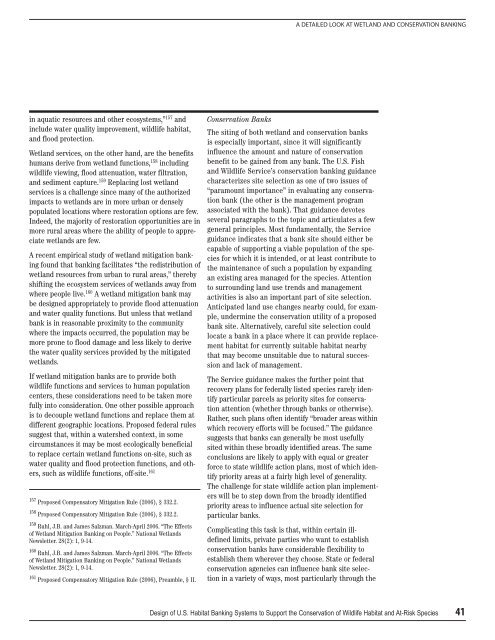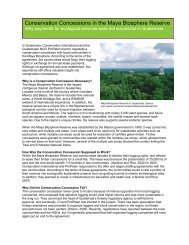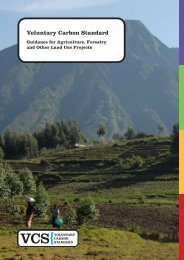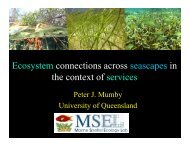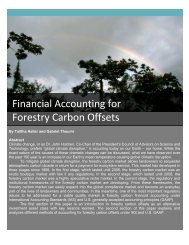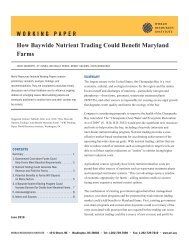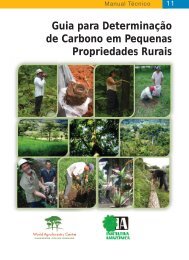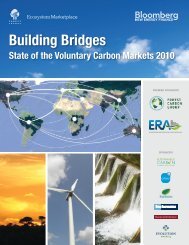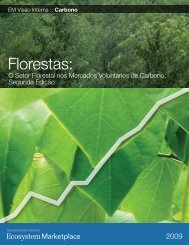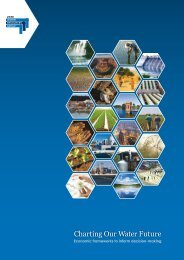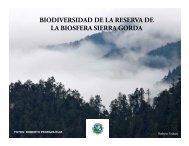Design of US Habitat Banking Systems to Support the Conservation ...
Design of US Habitat Banking Systems to Support the Conservation ...
Design of US Habitat Banking Systems to Support the Conservation ...
Create successful ePaper yourself
Turn your PDF publications into a flip-book with our unique Google optimized e-Paper software.
A DETAILED LOOK AT WETLAND AND CONSERVATION BANKINGin aquatic resources and o<strong>the</strong>r ecosystems,” 157 andinclude water quality improvement, wildlife habitat,and flood protection.Wetland services, on <strong>the</strong> o<strong>the</strong>r hand, are <strong>the</strong> benefitshumans derive from wetland functions, 158 includingwildlife viewing, flood attenuation, water filtration,and sediment capture. 159 Replacing lost wetlandservices is a challenge since many <strong>of</strong> <strong>the</strong> authorizedimpacts <strong>to</strong> wetlands are in more urban or denselypopulated locations where res<strong>to</strong>ration options are few.Indeed, <strong>the</strong> majority <strong>of</strong> res<strong>to</strong>ration opportunities are inmore rural areas where <strong>the</strong> ability <strong>of</strong> people <strong>to</strong> appreciatewetlands are few.A recent empirical study <strong>of</strong> wetland mitigation bankingfound that banking facilitates “<strong>the</strong> redistribution <strong>of</strong>wetland resources from urban <strong>to</strong> rural areas,” <strong>the</strong>rebyshifting <strong>the</strong> ecosystem services <strong>of</strong> wetlands away fromwhere people live. 160 A wetland mitigation bank maybe designed appropriately <strong>to</strong> provide flood attenuationand water quality functions. But unless that wetlandbank is in reasonable proximity <strong>to</strong> <strong>the</strong> communitywhere <strong>the</strong> impacts occurred, <strong>the</strong> population may bemore prone <strong>to</strong> flood damage and less likely <strong>to</strong> derive<strong>the</strong> water quality services provided by <strong>the</strong> mitigatedwetlands.If wetland mitigation banks are <strong>to</strong> provide bothwildlife functions and services <strong>to</strong> human populationcenters, <strong>the</strong>se considerations need <strong>to</strong> be taken morefully in<strong>to</strong> consideration. One o<strong>the</strong>r possible approachis <strong>to</strong> decouple wetland functions and replace <strong>the</strong>m atdifferent geographic locations. Proposed federal rulessuggest that, within a watershed context, in somecircumstances it may be most ecologically beneficial<strong>to</strong> replace certain wetland functions on-site, such aswater quality and flood protection functions, and o<strong>the</strong>rs,such as wildlife functions, <strong>of</strong>f-site. 161157 Proposed Compensa<strong>to</strong>ry Mitigation Rule (2006), § 332.2.158 Proposed Compensa<strong>to</strong>ry Mitigation Rule (2006), § 332.2.159 Ruhl, J.B. and James Salzman. March-April 2006. “The Effects<strong>of</strong> Wetland Mitigation <strong>Banking</strong> on People.” National WetlandsNewsletter. 28(2): 1, 9-14.160 Ruhl, J.B. and James Salzman. March-April 2006. “The Effects<strong>of</strong> Wetland Mitigation <strong>Banking</strong> on People.” National WetlandsNewsletter. 28(2): 1, 9-14.161 Proposed Compensa<strong>to</strong>ry Mitigation Rule (2006), Preamble, § II.<strong>Conservation</strong> BanksThe siting <strong>of</strong> both wetland and conservation banksis especially important, since it will significantlyinfluence <strong>the</strong> amount and nature <strong>of</strong> conservationbenefit <strong>to</strong> be gained from any bank. The U.S. Fishand Wildlife Service’s conservation banking guidancecharacterizes site selection as one <strong>of</strong> two issues <strong>of</strong>“paramount importance” in evaluating any conservationbank (<strong>the</strong> o<strong>the</strong>r is <strong>the</strong> management programassociated with <strong>the</strong> bank). That guidance devotesseveral paragraphs <strong>to</strong> <strong>the</strong> <strong>to</strong>pic and articulates a fewgeneral principles. Most fundamentally, <strong>the</strong> Serviceguidance indicates that a bank site should ei<strong>the</strong>r becapable <strong>of</strong> supporting a viable population <strong>of</strong> <strong>the</strong> speciesfor which it is intended, or at least contribute <strong>to</strong><strong>the</strong> maintenance <strong>of</strong> such a population by expandingan existing area managed for <strong>the</strong> species. Attention<strong>to</strong> surrounding land use trends and managementactivities is also an important part <strong>of</strong> site selection.Anticipated land use changes nearby could, for example,undermine <strong>the</strong> conservation utility <strong>of</strong> a proposedbank site. Alternatively, careful site selection couldlocate a bank in a place where it can provide replacementhabitat for currently suitable habitat nearbythat may become unsuitable due <strong>to</strong> natural successionand lack <strong>of</strong> management.The Service guidance makes <strong>the</strong> fur<strong>the</strong>r point thatrecovery plans for federally listed species rarely identifyparticular parcels as priority sites for conservationattention (whe<strong>the</strong>r through banks or o<strong>the</strong>rwise).Ra<strong>the</strong>r, such plans <strong>of</strong>ten identify “broader areas withinwhich recovery efforts will be focused.” The guidancesuggests that banks can generally be most usefullysited within <strong>the</strong>se broadly identified areas. The sameconclusions are likely <strong>to</strong> apply with equal or greaterforce <strong>to</strong> state wildlife action plans, most <strong>of</strong> which identifypriority areas at a fairly high level <strong>of</strong> generality.The challenge for state wildlife action plan implementerswill be <strong>to</strong> step down from <strong>the</strong> broadly identifiedpriority areas <strong>to</strong> influence actual site selection forparticular banks.Complicating this task is that, within certain illdefinedlimits, private parties who want <strong>to</strong> establishconservation banks have considerable flexibility <strong>to</strong>establish <strong>the</strong>m wherever <strong>the</strong>y choose. State or federalconservation agencies can influence bank site selectionin a variety <strong>of</strong> ways, most particularly through <strong>the</strong><strong>Design</strong> <strong>of</strong> U.S. <strong>Habitat</strong> <strong>Banking</strong> <strong>Systems</strong> <strong>to</strong> <strong>Support</strong> <strong>the</strong> <strong>Conservation</strong> <strong>of</strong> Wildlife <strong>Habitat</strong> and At-Risk Species 41


